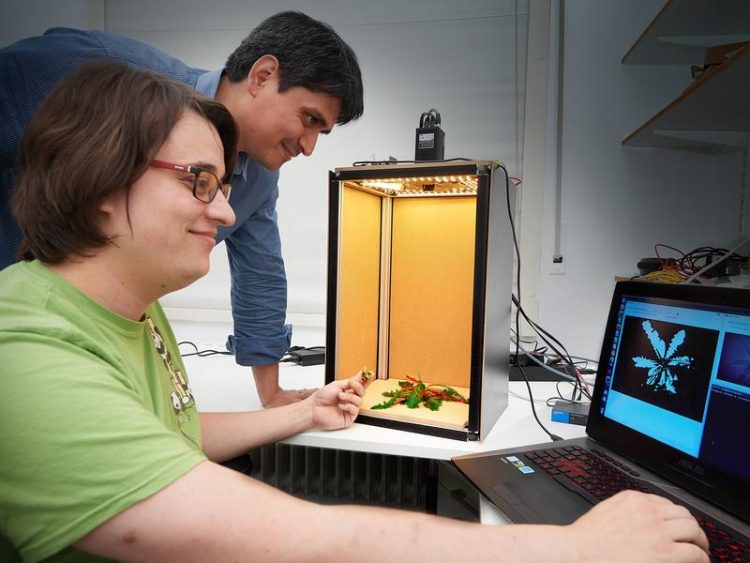Combatting weeds with lasers

Start-up: Tim Wigbels (left) and Dr. Julio Pastrana (right) with their weed recognition software which is detecting a plant and how the laser system is shooting and damage its foliage. © Photo: Volker Lannert/Uni Bonn
Those who want a rich harvest need to drive back weeds so that the crops can grow better. In organic agriculture, herbicides are ruled out as they are considered toxic chemicals, and unwanted plants must be laboriously weeded out. If the expectations of Dr. Julio Pastrana and Tim Wigbels are correct, this time-consuming work can soon be taken care of by robots.
Laser-based weed control can eliminate herbicides
The computer scientists in the Photogrammetry Laboratory at the Institute for Geodesy and Geoinformation at the University of Bonn are currently developing a novel system: using cameras on an all-terrain robot vehicle or even a tractor add-on, unwanted wild weeds should be automatically identified in the various crops and combatted in a targeted way.
“The robot shoots the leaves of the unwanted plants with short laser pulses, which causes a weakening in their vitality,” reports Dr. Pastrana. “It is thus predicted that we will no longer need to use herbicides on our fields and the environment will be protected,” adds Wigbels.
Before forming the start-up, Dr. Pastrana worked in robotics and researched automated image interpretation techniques with Prof. Cyrill Stachniss from the Institute of Geodesy and Geoinformation at the University of Bonn.
Dr. Pastrana completed his doctorate on the detection and classification of weeds with the aid of statistical models at Leibniz Universität Hannover and built an earlier version of the robot there with a colleague. Wigbels studied Computer Engineering at RWTH Aachen University and then worked in software development within a company.
The researchers are now pushing forward their start-up “Escarda Technologies” for one year at the University of Bonn with an EXIST grant from the Federal Ministry for Economic Affairs and Energy. “It is now a case of finding investors and further developing the business plan for the start-up,” says Wigbels. The researchers are also using the funding from the Ministry to buy the parts needed to construct a prototype.
Diverse support from the University of Bonn
Prof. Stachniss is supporting the start-up in various ways: Pastrana and Wigbels can thus use laboratories at the institution and consult with colleagues there. What’s more, Rüdiger Wolf from Technology Transfer at the University of Bonn helped the start-up to submit the application for the EXIST funding. “The advice was very helpful,” says Dr. Pastrana, delighted. Both scientists would also like to participate in the start-up round tables organized by Technology Transfer in order to benefit from the experience of other start-ups. The EXIST grant also enables them to attend training programs to prepare them for the challenges of independence.
“The idea combines innovative robots with a current sustainability topic,” says transfer advisor Rüdiger Wolf. He says the analyses of the market and competition for such an application are sound. Pastrana is convinced of the benefits of the laser-based technique for new agricultural machinery: “Our aim is to contribute to achieving more sustainable agriculture.” At the Bonn Idea Exchange by the Bonn/Rhein-Sieg Chamber of Commerce and Industry, both founders won an award for the best start-up idea.
Media contact:
Dr. Julio Pastrana
Tel. +49 (0)228/732908
E-mail: julio.pastrana@escarda.net
Tim Wigbels
Tel. +49 (0)228/732908
E-mail: tim.wigbels@escarda.net
http://www.escarda.net Internet
Media Contact
All latest news from the category: Agricultural and Forestry Science
Newest articles

A ‘language’ for ML models to predict nanopore properties
A large number of 2D materials like graphene can have nanopores – small holes formed by missing atoms through which foreign substances can pass. The properties of these nanopores dictate many…

Clinically validated, wearable ultrasound patch
… for continuous blood pressure monitoring. A team of researchers at the University of California San Diego has developed a new and improved wearable ultrasound patch for continuous and noninvasive…

A new puzzle piece for string theory research
Dr. Ksenia Fedosova from the Cluster of Excellence Mathematics Münster, along with an international research team, has proven a conjecture in string theory that physicists had proposed regarding certain equations….



